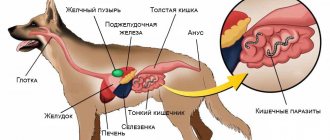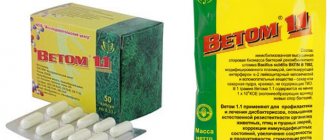Is it possible to protect a pet from infection with worms, and are those cat and dog owners right who are sure that their pet cannot possibly get helminthiasis because it does not go outside?
Unfortunately, no pet is guaranteed against infection with worm eggs (and this is how helminthiasis infection mainly occurs).
What to do in such a situation? To get started, we recommend reading this article. This article describes in detail methods of controlling parasites. We also recommend that you consult a specialist. Read the article >>>
And we, their owners, are obliged to understand the causes and types of helminthiasis, find out how to treat, what to treat, what pills or other drugs to use and what prevention to carry out.
Types of tapeworms in cats and dogs
Tapeworms, or cestodes, are only one of three main classes of helminths (in addition to them, there are also roundworms - nematodes and flukes - trematodes).
Tapeworms in cats and dogs are represented mainly by tapeworms (cucumber tapeworm, etc.), as well as broad tapeworm.
In the photo you can see what tapeworms look like, parasitizing mainly in the small intestine of animals, attaching to its walls with the help of a scolex - a head with suckers and/or special chitinous hooks.
Tapeworms do have a flat body ranging from 15 to 70 cm in length, but it is not uniform, like that of roundworms, but is, as it were, composed of many segments.
In each such segment, larvae mature, and as they mature, the parasite discards a segment, which comes out along with the animal’s feces, ruptures, and the eggs enter the external environment.
How to give medicine to a cat
There are several ways to give the pill to your pet:
- add powder from the crushed tablet to liquid food;
- holding the animal's paws, unclench the jaws and put the tablet in the mouth. Then you should pinch your jaws with your fingers and stroke your throat to trigger the swallowing reflex. After swallowing the tablet, release your jaw;
- mix the powder from the crushed tablet with a small amount of water. Pour from a syringe into your pet's mouth. The syringe must be without a needle;
Causes and routes of infection with tapeworms
The life cycle of tapeworms is as follows:
- an adult worm, parasitic in the small intestine of cats and dogs, discards a segment of its body (segment) with eggs, which is released along with feces;
- eggs released into the external environment are eaten by an intermediate host (for example, a flea or lice eater);
- a cat or dog swallows the intermediate host, and the larva develops into an adult worm in their body.
The sizes of cysts (eggs covered with a fairly durable shell) are so small that they easily penetrate the body of cats and dogs - their main hosts, and the cycle begins anew.
Naturally, the question arises: are these parasites transmitted to humans and dangerous to humans or not? Unfortunately, both questions will have to be answered positively: yes, they are transmitted and yes, they are dangerous.
However, the source of helminth infection is not only fleas and lice eaters. We ourselves bring worm eggs on the soles of our shoes, because they, as a rule, have good survival in the external environment and are found literally everywhere: on land, in water and even in the air, where they are carried by the wind.
Therefore, even in the absence of contact with street animals, helminthiasis may well develop at home, let alone those who “walk on their own”!
Why are tapeworms dangerous for cats?
An animal can become infected with helminths in various ways: by eating raw meat or fish, drinking water from a puddle, river, or through soil that contains parasite eggs.
Attention : many worms are transmitted through saliva from a cat to a person, so it is extremely important to promptly remove parasites from the animal.
Helminths are often found not only in humans, but also in representatives of the cat family.
Tapeworms in cats, photos of which are presented below, are flatworms, from 15 to 70 cm long. Their body is divided into segments where the larvae mature.
Parasites choose the small intestine as their habitat.
The following types of tapeworms can settle in the body of a pet:
- Flukes - quickly destroy internal organs (lungs, liver, bladder and gall bladder, intestines, pancreas).
- Cestodes are tapeworms in cats, a photo of which shows that they have a flat body up to 5 mm, as well as a head with suckers and chitinous hooks. These worms are not particularly dangerous for animals, but can cause a mortal threat to the human body (formation of metastases in the lungs, brain, liver oncology).
- The broad tapeworm is the largest parasite of this group. The worm causes vomiting and loss of appetite in the animal.
- Cucumber tapeworm can grow up to 30 cm in length in a pet's body. The parasite is absorbed by hooks into his intestines, damaging the mucous membrane and taking away nutrients.
Help: wide tapeworm can grow up to 150 cm in length.
Tapeworms in cats are dangerous because they injure the tissues of internal organs, causing necrosis and rupture of blood vessels.
Also, parasitic microorganisms feed on lymph and blood, which greatly depletes the animal’s body. In addition, helminths secrete toxins (remains of the decaying bodies of dead worms, waste products), which provoke poisoning and cause allergies.
Worms can clog the intestines, creating an obstruction that will require rapid surgical intervention as the cat may die.
Symptoms of tapeworm infection
A helminthic infestation may not manifest itself at first, but after some time attentive owners should notice certain symptoms indicating infection with tapeworms and the development of diseases caused by them:
- tapeworm segments resembling grains of rice are found on the hair around the anus, as well as in the feces;
- dull fur, loss of appetite, diarrhea and vomiting with blood, the development of anemia - all this indicates that the animal has diphyllobothriasis;
- dipilidia is characterized, in general terms, by the same symptoms, accompanied by severe rumbling in the abdomen and itching in the anus;
- alveococcosis usually has a severe chronic course, which causes a primary tumor-like lesion of the liver, which can metastasize to other organs of the animal (lungs, brain, etc.); the prognosis is negative, up to death.
General symptoms of helminthiasis
When worms appear in the intestines of an animal, the following characteristic clinical symptoms are determined for absolutely all types of parasites:
- deterioration of health, weakness, fatigue, lack of physical activity;
- eating uncharacteristic food, decreased or complete lack of appetite;
- deterioration in the quality of wool, which gradually thins out;
- there is no conjunctivitis in the eyes, but mucus and crusts form;
- dyspeptic reactions in the form of diarrhea, constipation, nausea, vomiting, abdominal pain;
- if there are a lot of helminths, intestinal obstruction occurs;
- suppression of the immune status, due to which the animal often suffers from viral and infectious diseases;
- the stomach becomes bloated, flatulence occurs;
- if parasites adhere to the intestinal wall, bleeding occurs, which is why the doctor can detect blood in the stool;
- the appearance of anemia, due to which the mucous membranes become pale;
- if a kitten is infected, its development is suspended, it is small in size compared to other individuals of the litter;
- if the parasite enters the blood, heart tissue or brain, convulsions, intoxication of the entire body, fainting, coma are formed;
- the appearance of large worms, which can be detected with the naked eye in feces or vomit.
To prevent the formation of helminthic infestations, the animal should be given prophylactic antiparasitic drugs. If this has not been done, you should immediately contact your veterinarian when the first symptoms appear.
Diagnosis and treatment of tapeworms
Before starting treatment, it is necessary to determine the type of helminthiasis and its causative agents.
This is due to the targeted effect that the anthelmintic drug has on the body of cats and dogs to destroy a specific type of parasite.
If the medicine is aimed at destroying tapeworms, then it will no longer work on roundworms. Where is the guarantee that only tapeworms are present in the animal’s body, and not a whole “company” of helminths?
The best option is to go to a veterinary hospital, where your pet will be tested to determine the type of worms and the best remedy for this helminthiasis will be selected.
Please note that self-prescription of anthelmintic drugs intended for humans is absolutely unacceptable: at best, they will not have the desired effect, and at worst, they can cause irreparable harm to the health of cats and dogs.
Ideally, a drug for worms should destroy them at all stages of development: eggs, larvae, and adult parasites, otherwise deworming will not give the desired effect.
This is exactly how the IN-AP complex works, simultaneously destroying parasite carriers (fleas, ticks, lice eaters, etc.).
Please also pay attention to what category of animals the anthelmintic drug is intended for - young or adult (a separate category for pregnant cats and dogs).
Some drugs are applied to the withers, but due to their high toxicity they can only be used on adult (and non-pregnant) individuals.
Such drugs as Drontal and Drontal Plus have proven themselves well, destroying not only tapeworms, but also roundworms. Febtal has a similar effect. Prazicide in the form of a sweet suspension also works well (it is available separately for kittens).
Among the drugs with a wide, that is, complex spectrum of action for deworming cats and dogs, we can note such drugs as Kanikquantel plus, Aziprin, Dirofen, Pratel. However, it should be taken into account that their degree of toxicity is higher, which can cause intoxication of animals.
You should not choose drugs only by name or cost; it is important to consider their impact and, of course, the effectiveness of deworming.
Traditional medicine has long known the means to get rid of worms: you need to add to the food of cats and dogs:
- oat or wheat bran; if you weigh less than 15 kg – 0.5 tsp, if you weigh more – 2 tsp;
- crushed garlic (you can use a garlic press) at the rate of: large dogs weighing more than 50 kg – 2 tsp. per day; smaller ones – 0.25-0.5 tsp; cats – 1/8 tsp. within 2 weeks;
- hot pepper or hot seasonings containing it; due to the occurrence of an aggressive environment in the intestines, some worms leave the body, and you can observe how they come out along with the feces;
- certain types of herbs and plants (after consultation with a veterinarian).
Features of tapeworms
The long body of worms belonging to this species consists of several segments that have their own reproductive organs, which increases the chances of survival when changing hosts. At the end of the worm there is a head with attachment devices. Occasionally, cestodes with an undivided body are found. The intermediate host of parasites can be fleas, fish, pigs, and other domestic animals. The cat's digestive tract is usually inhabited by adults. Most often it is pumpkin tapeworm, broad tapeworm, echinococcus, spirometra.
A pet becomes infected by eating raw meat or fish. Having attached themselves to the intestinal mucosa, parasites suck out beneficial substances and microelements from the animal’s body.
Visually, you can detect worms in a cat in the feces, in the anal area in the form of segments that externally resemble cucumber seeds up to 8 mm in size.
Prevention
Paradoxical as it may sound, it is the constant desire for cleanliness, which is expressed in licking fur, that causes helminthiasis in cats, since in the process of their “hygienic procedures” they swallow carriers of fleas and whipworms - the main carriers of cestodes. Dogs simply bite off fleas.
Therefore, deworming should be carried out regularly, preferably quarterly or at least 2-3 times a year, and with exactly the drugs recommended by the veterinarian specifically for your pet.
In parallel with this, it is necessary to remove fleas. If your pets walk outside, then infection with worms is inevitable.
If they lead an exclusively home lifestyle, then as a preventive measure they should:
- inspect them for fleas as often as possible;
- do not feed raw meat and fish;
- when changing the toilet, wash the tray with disinfectants;
- Do wet cleaning in the house with special detergents as often as possible;
- put outdoor shoes in a tightly closed cabinet to prevent contact of animals with them.
Take care of your pets, and then they will bring you only joy, and not unpleasant surprises in the form of worms.
Preventive actions
To prevent the appearance of worms, it is necessary to destroy fleas. After all, these insects are carriers of helminths.
For this purpose, it is necessary to regularly disinfect the house and yard. And to remove insects from a cat, special shampoos, drops or collars are used.
To prevent tapeworms from appearing in your cat, the first step is to carefully care for it. Therefore, it is necessary to periodically examine the animal’s feces and not feed it raw fish or meat.
The animal should be bathed regularly and do not forget about your own hygiene, which consists of thoroughly washing your hands after contact with the cat. In addition, the cat's litter box, rug and floor in the house where the cat lives must be constantly washed and disinfected.
Parasitic infections in cats are the most common problem faced by pet owners. Infection with worms cannot be considered a harmless phenomenon. It threatens serious health problems, in advanced cases leading to the death of the animal. Many parasites can pose a danger to humans. Of the many varieties of helminths, tapeworms are especially common in cats. Attaching to the intestinal walls using a hook-shaped mouth or suction cups, they have a destructive effect on the digestive tract. In order to take timely steps to combat parasites, you need to know about the peculiarities of their vital functions and symptoms indicating infection.
It is possible to defeat parasites!
Antiparasitic Complex® - Reliable and safe removal of parasites in 21 days!
- The composition includes only natural ingredients;
- Does not cause side effects;
- Absolutely safe;
- Protects the liver, heart, lungs, stomach, skin from parasites;
- Removes waste products of parasites from the body.
- Effectively destroys most types of helminths in 21 days.
There is now a preferential program for free packaging. Read expert opinion.
Interesting to know:
Ways to infect cats with parasites
Did you know that a cat that has fleas is highly likely to have worms?
There are two types of tapeworms that commonly infect a cat, and these tapeworms have different intermediate hosts.
Dipylidium satpit (the most common cat tapeworm) uses fleas as its method of spread.
- Cats with fleas are more likely to have tapeworm infestation because immature fleas feed on tapeworm eggs in the cat's feces. The tapeworm develops inside the flea (intermediate host), and when the cat licks itself and swallows the flea, its digestive juices break down the flea's body and release the larval form of the tapeworm.
- Therefore, regular flea monitoring is important to prevent your cat from becoming infected.
Cats that go outdoors and hunt rodents are more likely to become infected with tapeworm.
The second most common species of tapeworm is Thaeta taeniaeformis, whose larval stage takes place inside rodents such as rats and mice.
Therefore, hunting cats are more likely to be infected with this type of tapeworm.
- Rodents become infected with the larval form of tapeworm when they eat plants contaminated with cat feces containing tapeworm eggs. The tapeworm burrows into the muscles of rodents and when a cat hunts and eats an infected rodent, it infects itself with the tapeworm.
- Therefore, hunting cats should be examined regularly, ideally every month.
Bibliography
- Centers for Disease Control and Prevention. Brucellosis. Parasites. Link
- Corbel MJ Parasitic diseases // World Health Organization. Link
- Young EJ Best matches for intestinal parasites // Clinical Infectious Diseases. — 1995. Vol. 21. - P. 283-290. Link
- Yushchuk N.D., Vengerov Yu.A. Infectious diseases: textbook. — 2nd edition. - M.: Medicine, 2003. - 544 p.
- Prevalence of parasitic diseases among the population, 2009 / Kokolova L. M., Reshetnikov A. D., Platonov T. A., Verkhovtseva L. A.
- Helminths of domestic carnivores of the Voronezh region, 2011 / Nikulin P. I., Romashov B. V.
An article for patients with a doctor-diagnosed disease. Does not replace a doctor's appointment and cannot be used for self-diagnosis.
The best stories from our readers
Topic: Parasites are to blame for all troubles!
From: Lyudmila S. ()
To: Administration Noparasites.ru
Not long ago my health condition worsened. I began to feel constant fatigue, headaches, laziness and some kind of endless apathy appeared. Problems also appeared with the gastrointestinal tract: bloating, diarrhea, pain and bad breath.
I thought it was because of the hard work and hoped that it would go away on its own. But every day I felt worse. The doctors couldn’t really say anything either. Everything seems to be normal, but I feel like my body is not healthy.
I decided to go to a private clinic. Here I was advised, in addition to general tests, to get tested for parasites. So in one of the tests they found parasites in me. According to doctors, these were worms, which 90% of people have and almost everyone is infected, to a greater or lesser extent.
I was prescribed a course of antiparasitic medications. But it didn’t give me any results. A week later, a friend sent me a link to an article where some parasitologist shared real tips on fighting parasites. This article literally saved my life. I followed all the advice that was there and after a couple of days I felt much better!
Digestion improved, headaches went away and the vital energy that I so lacked appeared. To be sure, I took the tests again and no parasites were found!
Anyone who wants to cleanse their body of parasites, no matter what types of these creatures live in you, read this article, I’m 100% sure it will help you! Go to article>>>
Still have questions? Ask them in our Anonymous group on VK
How to get rid of parasites in a week. The answer is here!
A reliable and effective remedy for combating worms. Removes all parasites in 21 days.
Go to website
Reviews
Read online
Symptoms that 100% indicate parasites! Take the Test.
How to rid your body of life-threatening parasites before it’s too late!
Read more
Website
To get a consultation
The doctor tells how to quickly get rid of parasites for adults and children!
A parasitologist explains what effective methods exist to combat helminths.
More details
Read completely
Comments
Search for cures for parasites
This service is a small help in finding cures for parasites. To start using it, select the type of parasite. If you don’t know what kind of parasite you are infected with, this parasite identification tool will help you by symptoms.
We recommend reading
Toxoplasmosis in dogs: routes of infection, symptoms and treatment
01/29/202102/01/2021ecoliv94
Worm inspector for cats: instructions for use, cost
01/27/202102/02/2021ecoliv94
Products for cats against ticks and worms: list of the best
01/25/202102/3/2021ecoliv94
Dirofen against worms for cats and dogs: instructions for use, price, analogues
01/25/202102/3/2021ecoliv94
Treatment
It is important to diagnose helminthic infestation in time. Timely treatment will allow you to quickly get rid of parasites. Today there is a large selection of anthelmintic drugs for cats. They allow you to easily cope with helminths at any stage of development, without causing a toxic effect on the pet’s body. Available in a variety of forms. Your veterinarian will help you choose the right medicine and determine the dosage, taking into account the type of worms and the general condition of your pet.
Pills
There are drugs in tablet form that are used once. You can give the medicine forcibly by placing the tablet on the root of the tongue, or crush it and mix it with water and pour it into the mouth using a syringe. During the treatment process, it is important to ensure that the pet does not spit out the medicine. The most popular medications to help control tapeworms in cats are:
- Holiday plus. The active ingredients are fenbendazole and praziquantel. By interacting with each other, they block the functioning of the muscle and nervous systems of the parasites, which causes the death of the latter. The remains of worms are excreted in the feces. The dosage depends on the weight of the pet - one tablet is designed for 10 kg of weight. If the cat weighs 5 kg, then he needs to be given half the tablet. Kanikvantel is suitable both for the treatment of helminthic infestation and for prevention. In severe cases of the disease, it is recommended to take the medication again after 2 weeks. The drug has a gentle effect. Even a significant excess of the dosage does not have a negative effect on the body. In rare cases, adverse reactions such as vomiting and diarrhea are possible. These symptoms usually go away on their own after a few hours. This product is contraindicated in pregnant cats and kittens under three weeks of age.
- Drontal. Available in the form of white coated tablets. The active substances pyrantel embonate and praziquantel have a paralyzing effect on helminths, which leads to their death. Quickly absorbed into the intestinal villi, they penetrate all organs. Excreted through the kidneys. Easily tolerated by all cats, regardless of breed and age.
- Pratel. Praziquantel and pyrantel are the main components. The drug is a yellowish anthelmintic tablet that is effective against many types of parasites, including tapeworms. By paralyzing the muscles and blocking the transmission of nerve impulses, it destroys adult helminths, as well as larvae.
Medicine for worms must be given exactly according to the indicated dosages.
Drops on the withers
This form of anthelmintic drugs is convenient when the animal refuses to take the medicine orally. Drops are applied to the occipital region once. Effective:
- Profender. An anthelmintic drug used for therapeutic and prophylactic purposes. Available in the form of a solution containing emodepside and praziquantel, components known to be effective against tapeworms. Having penetrated the animal’s skin into the body, the drug paralyzes the neuromuscular system of the parasite, causing its death. It can be maintained for a long time in therapeutic concentrations and is eliminated within 30 days.
- Stronghold. A colorless solution containing selamectin as an active substance. Effective against many parasites, providing reliable protection for a month. If the specified dosage is observed, the drug is completely safe for the pet’s health.
- Prazicide-complex. Broad spectrum drops. The composition includes a complex of active substances - praziquantel, ivermectin, levamisole, thiamethoxam. Refers to moderately dangerous drugs.
Drops are applied to the occipital region once. Having parted the animal's fur, squeeze the contents of the pipette onto the skin in accordance with the recommended dosage. Manipulation should be carried out carefully so that the medicine does not get on your hands.
Suspensions
The medicine has a sweetish taste. Injected into the oral cavity using a syringe. The following drugs have found widespread use:
- Prazicide plus. Suitable for adult animals and kittens over 3 weeks old.
- Pirantel. Leads to disruption of the motor function of parasites, as a result of which tapeworms cannot attach to the intestinal walls and are excreted from the body. The drug cannot affect migrating larvae.
- Prazitel. Disturbs the energy metabolism of parasites. Output quickly.
The advantage of drugs in the form of a suspension is the inability of the animal to remove the injected drug from the mouth.









